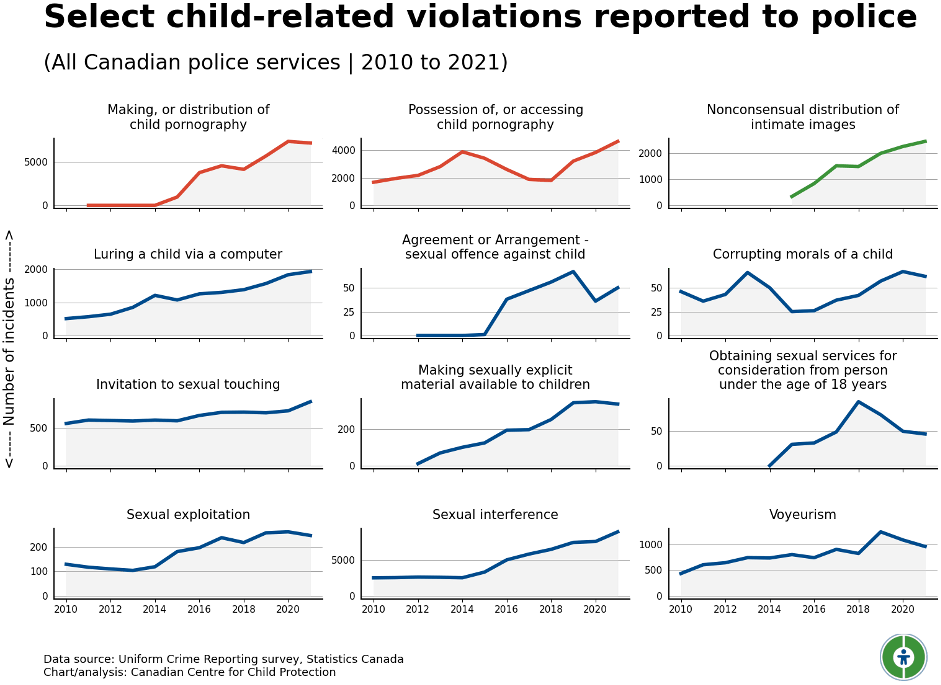Sexual crimes against Canadian children rising at alarming rate, new Stats Can police‑reported data shows
Reported incidents of sexual interference up 18 per cent; possessing and accessing of child sexual abuse material incidents up 21 per cent compared to previous year.
For Immediate Release
Winnipeg, Canada — Sexual crimes against Canadian children continue to trend upwards at an alarming rate, the latest release of police‑reported crime data by Statistics Canada shows. Several key child‑related violations have been steadily trending upwards over previous years, fuelled in large part by the use of technology.
The statistics for the year 2021, paint a disturbing picture, notably:
- Sexual interference incidents have increased by 1,340 cases, representing an 18 per cent increase compared to 2020. This is a 38 per cent increase in incidents compared to the previous five‑year average (2016‑2020).
- Possession of, or accessing child pornography* incidents have increased by 807 cases, representing a 21 per cent increase compared to 2020. This is a 74 per cent increase in incidents compared to the previous five‑year average.
- Luring a child via a computer incidents have increased by 96 cases, representing a five per cent increase compared to 2020. This is a 31 per cent increase in incidents compared to the previous five‑year average.
- Non‑consensual distribution of intimate images incidents, which can involve adult or child victims, have increased by 194 cases, representing a nine per cent increase compared to 2020. This is a 52 per cent increase in incidents compared to the previous five‑year average.
Per cent increases and five‑year averages calculated by staff at the Canadian Centre for Child Protection using Statistic Canada’s incident‑based crime statistics.
“These concerning increases are being facilitated by social media platforms and other electronic services providers; it should be a wakeup call,” says Lianna McDonald, Executive Director for the Canadian Centre for Child Protection (C3P). “This reinforces the need for the government to swiftly impose regulatory guardrails around the technology industry, just as we are seeing take place in other countries. We don’t allow other types of manufacturers to introduce products into the Canadian market that pose a risk to the public. Yet, in the digital space, it’s a free‑for‑all at the expense of children.”

These police‑reported figures mirror a distressing pattern observed by analysts with Cybertip.ca, Canada’s tipline to report online child sexual abuse and exploitation, which is operated by C3P.
“It is clear offenders seek out children where they are easily found - on the social platforms they engage with for hours each day,” says McDonald.
Online safety tips for families
- Have regular conversations about online safety. This includes talking about the online games your kids are playing, the apps they’re using, and who they are chatting with. For tips on how to get the discussion started, visit protectkidsonline.ca for age‑appropriate ideas.
- Set the expectation you will monitor your child’s online activities, and work together to establish guidelines around texting, social media, live streaming, and gaming, such as who your child can do these things with and on what apps.
- For younger children, help them create their login, password, and profile information ensuring it is set to private. For tweens and teens, help set up privacy settings in apps/games/social accounts. With a private account, users can approve or deny followers/friends, restrict who can view their content and profile information, and limit incoming messages to followers/friends only. Work together to decide who to accept as followers/friends.
- Tell your child that if they come across something or someone while online that makes them feel uncomfortable, they can tell you without fear of getting in trouble or losing digital privileges. Remind them their safety is what is most important to you.
- Remember, there’s no amount of online filters or safety controls that can replace parental supervision and communication.
- If you see, read, or hear anything sexual from an adult towards your child online, report it to Cybertip.ca.
- * “Child pornography” is the term used in the Criminal Code of Canada. The term “child sexual abuse material” more clearly describes the assaults taking place against children and is a more accurate term for images and videos depicting this form of abuse. ↩
1 (204) 560-0723
communications@protectchildren.ca